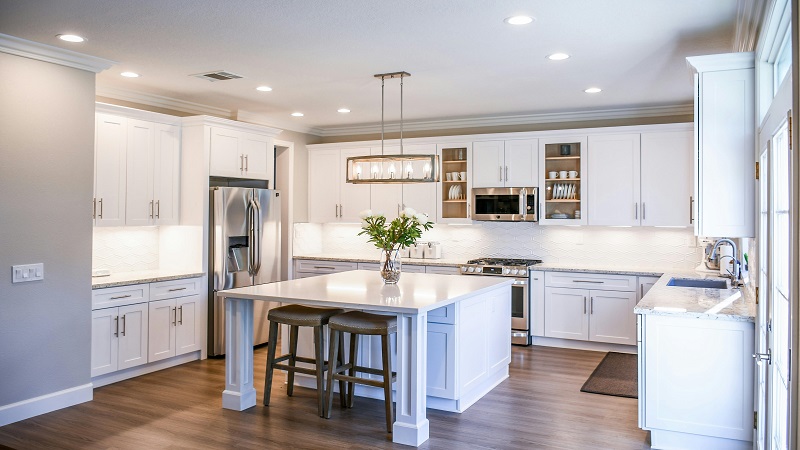Renovating a kitchen is a significant undertaking that requires meticulous planning and informed decision-making. This article presents “10 Practical Considerations When Renovating a Kitchen,” offering essential advice on key areas such as budget allocation, choosing suitable materials, and designing optimal layouts. It explores the significance of lighting, the smart selection of appliances, creative storage solutions, and innovative countertop and backsplash designs. The article encourages effective use of space and emphasizes the importance of consulting professionals for a successful renovation. Ultimately, it provides readers with the guidance necessary to transform their kitchens.
1. What Is Your Budget?
Begin by establishing a realistic budget that covers all potential expenses. Factor in costs like labor, materials, appliances, and contingencies. Over-budgeting by 10-20% can help accommodate unexpected costs that may arise. Determine your must-haves and prioritize them over non-essential upgrades to ensure the project remains within financial constraints. Planning your budget early also sets clear expectations and prevents overspending, making it easier to find quality alternatives and control costs as you proceed.
2. Know the Right Materials
Selecting durable, high-quality materials ensures that your renovation investment will withstand the rigors of daily kitchen use. Focus on stain-resistant countertops, moisture-proof cabinetry, and resilient flooring. Research various materials based on your cooking habits, aesthetic preferences, and maintenance needs. For instance, quartz countertops offer low maintenance, while solid wood cabinetry exudes warmth. Apply rubber sealant to joints and seams to prevent moisture infiltration and improve durability. Choosing the right materials enhances longevity, reduces maintenance efforts, and adds lasting value to your renovation.
3. Optimal Layout Planning
Your kitchen’s layout should accommodate efficient workflow, allowing seamless movement between the sink, stove, and refrigerator, commonly known as the kitchen triangle. Consider work zones that cater to food preparation, cooking, and cleaning. For example, place the sink near the dishwasher and allow counter space next to the stove for meal assembly. The layout should also account for traffic flow, making sure that multiple people can navigate without obstruction.
4. Lighting Design
Illuminate your kitchen properly by combining ambient, task, and accent lighting. Ambient lighting provides general illumination, while task lighting is crucial for areas like countertops and the sink. Consider under-cabinet lighting to eliminate shadows during food preparation. Accent lighting highlights architectural features or decor elements. Incorporating dimmers offers flexibility, letting you switch from functional cooking light to ambient mood lighting when entertaining.
5. Pick the Appliances Wisely
Choosing the right appliances depends on your cooking style, kitchen size, and energy efficiency goals. Compact models save space in small kitchens, while high-capacity appliances cater to large families. Look for Energy Star-rated models to minimize energy consumption. Consider the placement of each appliance to ensure smooth workflow and maintain access to power and water lines. Investing in smart technology can also enhance convenience and streamline daily tasks.
6. Give Preference to Storage Solutions
Maximizing storage reduces clutter and improves organization. Utilize pull-out shelves, deep drawers, and corner cabinets to access every inch of space. Install vertical storage racks for pots, pans, and spices, or incorporate pull-out pantry systems. Tailor storage solutions to your cooking habits, making frequently used items easily accessible. Concealed storage maintains a clean, modern appearance while keeping essentials within reach.
7. Experiment With Countertop Choices
Explore different countertop materials like quartz, granite, laminate, or butcher block. Each material has its advantages and drawbacks, so consider your cooking style and maintenance preferences. Quartz offers low maintenance, while butcher block provides a warm, rustic appeal. A mix of materials can add character and practicality; for instance, use a butcher block for a breakfast bar and granite for food preparation. Selecting the right countertop material enhances both the aesthetic and functional aspects of your kitchen.
8. Go for a Backsplash Design
Backsplashes protect walls from splatters and add a decorative touch to your kitchen. Choose materials like ceramic tiles, glass, stainless steel, or natural stone based on the style and color scheme of your kitchen. Mosaic tiles add artistic flair, while large-format tiles create a sleek, seamless look. Experiment with different patterns, colors, and textures to create a visually appealing yet practical backsplash that complements your overall design.
9. Use Space Smartly
Efficiently utilizing available space is essential, particularly in smaller kitchens. Opt for multi-functional furniture like an island with storage or extendable tables. Install wall-mounted racks or magnetic strips to keep utensils and knives off the counter. Open shelving can display decorative items while providing storage, and custom cabinetry can maximize corners and nooks. Tailor solutions to your kitchen size and lifestyle to ensure you make the most of the space.
10. Get a Professional Consultation
A professional designer or contractor provides expert insights into creating a cohesive and practical kitchen design. They can recommend the best materials, offer layout suggestions, and help navigate building codes. Professionals also provide detailed cost estimates and help manage timelines, preventing costly delays. By collaborating with an expert, you avoid common pitfalls and bring your renovation vision to life within the constraints of your budget and timeline.
The Final Word
Kitchen renovations are a balance of creativity, practicality, and financial planning. By prioritizing these ten considerations, you’ll create a functional, stylish, and valuable kitchen that meets your needs. A well-planned renovation not only enhances daily life but also adds long-term value to your home. Approach each step thoughtfully, and don’t hesitate to seek professional guidance for a renovation that aligns with your goals.
